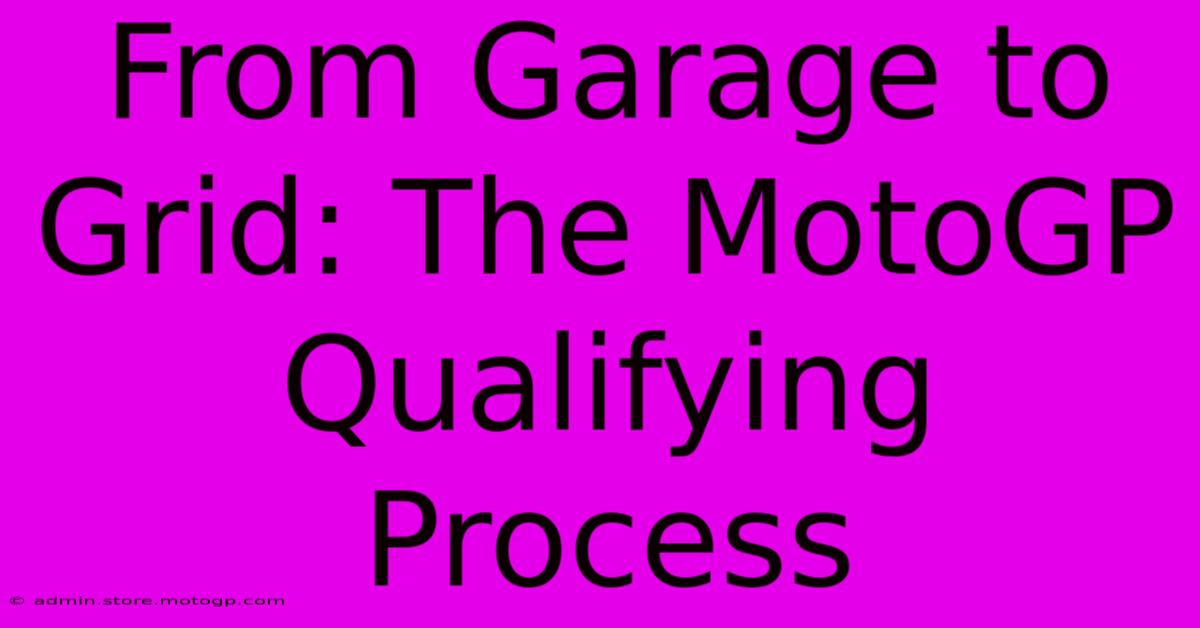From Garage To Grid: The MotoGP Qualifying Process

Table of Contents
From Garage to Grid: The MotoGP Qualifying Process
MotoGP, the pinnacle of motorcycle racing, captivates millions with its breathtaking speeds and nail-biting competition. But before the lights go out and the roar of engines fills the air, a crucial process determines the starting grid: qualifying. This isn't just a matter of fastest lap; it's a strategic dance of tire management, track conditions, and sheer skill. Let's delve into the intricacies of how riders earn their starting positions.
Understanding the Qualifying Format
The current MotoGP qualifying format is a multi-stage process designed to create excitement and showcase the riders' abilities under pressure. It's a far cry from the simpler qualifying sessions of the past.
Q1: The Fight for Q2
The first qualifying session, Q1, is a 15-minute shootout for the ten slowest riders from the combined Free Practice sessions (FP1, FP2, and FP3). This initial session is crucial. Only the two fastest riders from Q1 progress to Q2, leaving the remaining eight to start the race from positions 13-20 on the grid. The pressure is immense; one mistake can mean the difference between a prime starting position and a challenging race from the back. This session often showcases some of the most aggressive riding as riders push their machines to the absolute limit.
Q2: The Battle for Pole Position
Q2, a further 15-minute session, involves the top 10 riders from the combined Free Practice sessions, plus the two fastest from Q1. This is where the real drama unfolds. The rider who records the fastest lap time in Q2 secures pole position, the coveted spot at the front of the grid for the race. The remaining positions in the top 12 are filled according to the next fastest lap times. The competition is fierce, with riders constantly vying for improvement, often pushing the boundaries of their machines and their own limits.
Strategies and Tactics in Qualifying
Qualifying is not simply about brute speed; it's a complex strategy game. Riders and teams consider several key factors:
Tire Management: A Delicate Balance
Choosing the right tires is paramount. While soft tires offer superior grip and potentially faster lap times, they degrade more quickly. Riders and teams need to make crucial decisions about which tires to use and when, balancing the pursuit of a fast lap with the need to conserve tires for the race. A worn-out tire in qualifying could mean a poor starting position, severely impacting the race result.
Track Conditions: Adapting to Change
Track temperature, grip levels, and even the presence of wind can significantly impact lap times. Experienced riders and their crews continuously monitor these conditions to make informed decisions about tire choice, bike setup, and riding style. Adjusting to changing conditions is a key skill that separates the best from the rest.
Slipstreaming: The Art of Teamwork (and sometimes, not)
Slipstreaming, or drafting, plays a significant role in qualifying. Riders can gain a significant speed advantage by following closely behind another rider, benefiting from their aerodynamic wake. This tactic requires precise timing and execution, and it's not uncommon to see riders working together, or even engaging in strategic battles, to gain this advantage.
The Importance of Qualifying
The starting grid position significantly influences the race outcome. Starting from pole position offers a significant advantage, allowing the rider to control the race pace and avoid getting caught in traffic. While overtaking is possible in MotoGP, a strong starting position dramatically improves the chances of achieving a better result. A bad qualifying performance often means a much harder race, requiring the rider to battle their way through the pack.
Conclusion
The MotoGP qualifying process is more than just a time trial; it's a high-stakes strategic competition that showcases the riders' skills, the teams' meticulous preparation, and the relentless pursuit of perfection. From the intense pressure of Q1 to the nail-biting battle for pole in Q2, qualifying sets the stage for the electrifying races that make MotoGP the thrilling spectacle it is. Understanding this process enhances the viewing experience, allowing fans to appreciate the complexity and strategy behind the starting grid formation.

Thank you for visiting our website wich cover about From Garage To Grid: The MotoGP Qualifying Process. We hope the information provided has been useful to you. Feel free to contact us if you have any questions or need further assistance. See you next time and dont miss to bookmark.
Featured Posts
-
Cota The Ultimate Riding Destination
Feb 20, 2025
-
Experience The Thrill Cota Track Day Awaits
Feb 20, 2025
-
General Admission Cota F1 The Essence Of F1
Feb 20, 2025
-
Moto Gp Aerodynamics Pushing The Limits Of Performance
Feb 20, 2025
-
Invest In Quality Premium Motorcycle Helmet Replicas
Feb 20, 2025
